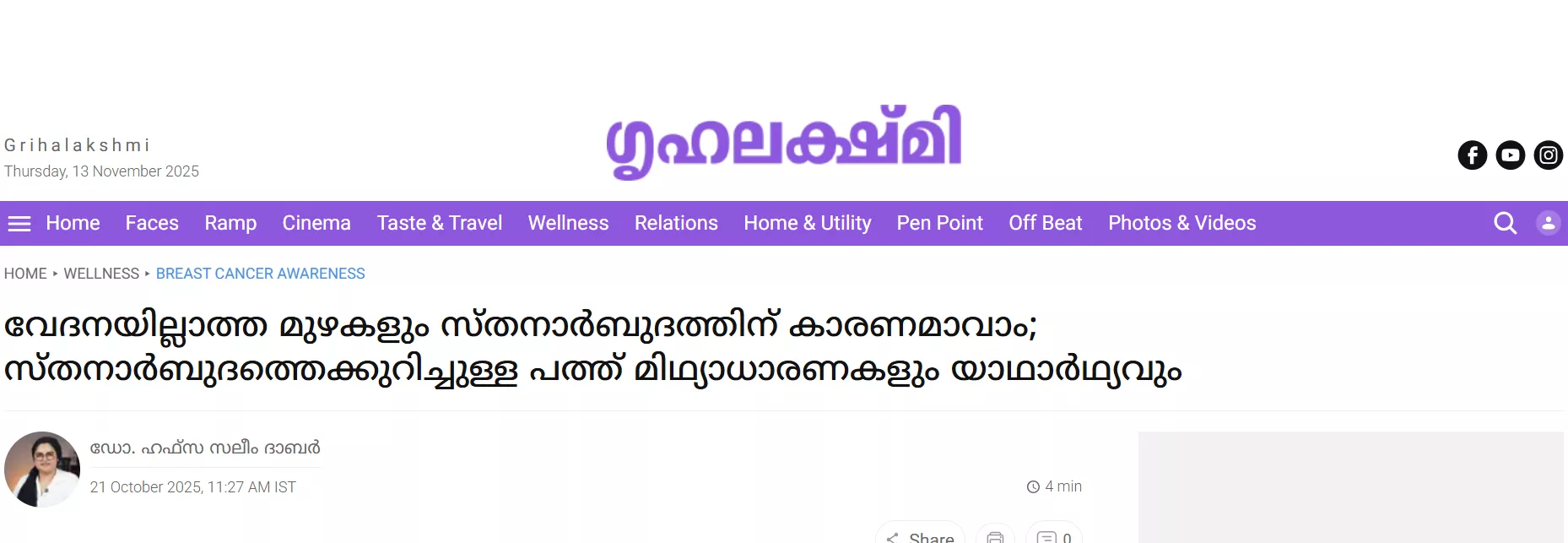"As part of global breast cancer awareness, every year the month of October is observed as Pink October."
Breast cancer remains one of the leading causes of death among women worldwide.
However, through widespread awareness campaigns, it has become possible to detect breast cancer early, provide effective treatment to a certain extent, and thereby reduce the mortality rate associated with the disease. Although a large section of the population is aware of the general facts about breast cancer, some people still hold on to certain misconceptions.
This article aims to clarify some of the common myths in society and present the actual facts behind them.
1) Only women are affected by breast cancer.
It is true that breast cancer is more commonly seen in women, but the belief that it affects only women is a misconception. About 1% of men can also develop breast cancer. Due to overconfidence and the assumption that they are not at risk, men often fail to recognize the symptoms early, leading to delayed diagnosis.
This can lead to a complication of the disease’s condition. Therefore, if any common symptoms of breast cancer—such as changes in the skin color of the breast (redness or other discoloration), thickening, or nipple discharge—are noticed, men should also promptly consult a doctor to ensure that it is not breast cancer.
2) A lump is the only symptom of breast cancer.
This is a misconception. Symptoms of breast cancer can also include changes in the shape or size of the breast, nipple discharge, wrinkling or dimpling of the skin, redness, or pain in the breast.
Many people tend to delay medical consultation, assuming that “there’s no lump, so it’s nothing serious.”
However, if any of the above symptoms are noticed, it is important to consult a doctor immediately to ensure that it is not breast cancer.
3) Breast cancer is purely a hereditary disease.
This is one of the most common misconceptions. Many people think, “No one in my family has had breast cancer, so why should I be cautious?” In reality, only a small percentage (less than about 10%) of breast cancer cases are caused by hereditary factors. Other factors such as lifestyle choices, hormonal changes, and environmental influences also play a significant role in increasing the risk of developing breast cancer.
4) Using bras or deodorants causes breast cancer.
This is a myth with no scientific basis. Many people believe that wearing bras—especially tight-fitting ones—can cause breast cancer, but no study has ever proven this claim.
Similarly, the use of deodorants or antiperspirants has not been scientifically shown to cause breast cancer.
5) Mammograms can cause breast cancer.
Because of this misconception, many people hesitate to undergo a mammogram.
In reality, the amount of radiation used in a mammogram is very minimal, and the procedure has been proven to be completely safe. A mammogram does not cause breast cancer in any way.
In fact, it is one of the most effective diagnostic tools currently available for early detection of breast cancer.
Therefore, this unfounded fear should not prevent anyone from getting a mammogram when recommended.
6) Young women do not get breast cancer.
Generally, breast cancer is more common in women over the age of 40.
However, it is not rare among younger women either.
Factors such as unhealthy lifestyle habits, obesity, and substance use are often considered contributing causes for the occurrence of breast cancer at a younger age.
7) After a mastectomy, breast cancer will never return.
Some people believe that once they’ve had a mastectomy (surgical removal of the breast), they are completely free from the risk of breast cancer and therefore no longer need follow-ups or preventive care.
While surgery can successfully remove most cancerous tissues and is often highly effective, regular follow-up checkups, medications, and monitoring are still essential .In rare cases where the disease recurs, these ongoing evaluations help detect it early and make timely treatment possible.
8) Breast cancer always requires complete removal of the breasts.
In the past, the main treatment for breast cancer was surgical removal of the entire breast (mastectomy).
However, with advancements in modern medical science, it is now possible to treat breast cancer successfully without removing the breasts entirely. When surgery is necessary, there are procedures that remove only the lump (tumor) while preserving the breast.
Even in cases where complete removal is required, breast reconstruction surgery options are available today, allowing women to restore the breast’s appearance and confidence.
9) Herbal or traditional remedies are more effective than modern medicine.
This is a false and unscientific belief.
Relying on unproven or alternative treatments not only fails to cure the disease but can also worsen the condition by delaying proper medical care.
Despite the availability of advanced and scientifically proven treatments such as surgery, chemotherapy, radiation therapy, and targeted therapy, some people still turn to unscientific methods, which can be dangerous and ineffective
10) Lumps that cause breast cancer are always painful.
This is one of the most widespread misconceptions. Because of this belief, many women ignore painless lumps, assuming that they cannot be cancerous. Since the breast is a private part of the body, women often hesitate to talk about such issues, further delaying medical attention .In reality, not all cancerous lumps cause pain. Therefore, any lump that appears in the breast—whether painful or not—should be examined by a doctor immediately to ensure it is not cancerous.
The author of the article is a General and Laparoscopic Surgeon (Dr. Hafsa Salim Daber )at Aster Mother Hospital, Areekode.


